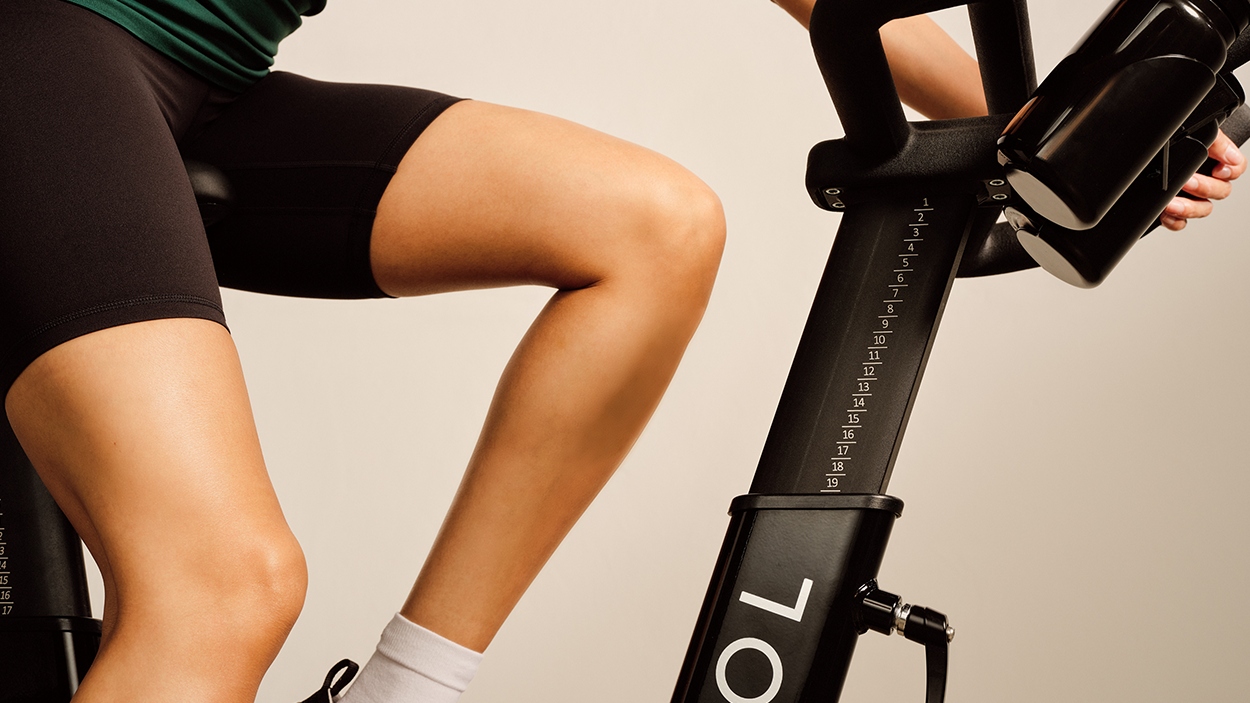Our body utilizes 2 main energy systems during training: aerobic and anaerobic. It can switch between them during the same workout, for instance, in stationary bike cycling. These systems can be harnessed to achieve different goals, whether it’s weight loss, performance enhancement, or improving cardiovascular fitness. By incorporating both aerobic and anaerobic exercises into your workout routine, you can maximize the benefits and tailor your training to meet your specific objectives. Discover how to make the most of these energy systems and create a well-rounded workout plan.
Anaerobic and aerobic energy systems
The energy derived from food is stored in your muscles as adenosine triphosphate (ATP). During your workout, ATP is converted back into energy through 3 energy systems: phosphagen, anaerobic, and aerobic.
The phosphagen system, also known as anaerobic ATP-PC, relies on the immediate energy reserve of ATP stored in your muscles. It doesn’t require oxygen to synthesize ATP and provides a powerful burst of energy for very short periods, typically lasting 8-10 seconds. Sprinters in a 100-meter race primarily rely on the phosphagen system. After the initial 10 seconds, the body switches to either the anaerobic glycolytic or aerobic energy system.
The anaerobic glycolytic energy system uses glycogen (sugar stored in muscles) to turn it into ATP. Unlike the aerobic system, it does not rely on oxygen supply from the heart and lungs, allowing it to activate more quickly. This energy system is capable of providing energy for approximately 120 seconds, making it suitable for short bursts of high-intensity exercise such as a 400-meter sprint or interval swimming.
During anaerobic energy production, lactic acid is released in muscles as a by-product which can lead to pain and discomfort during prolonged training. The lactate threshold refers to the point during intense exercise where lactate accumulates in the bloodstream faster than the body can remove it, resulting in fatigue.
The aerobic energy system is activated last, approximately 2 minutes into exercise, as the heart and lungs deliver oxygen to the muscles, triggering a chemical reaction. This system enables the cell mitochondria to generate energy from glucose obtained from glycogen stores, the bloodstream, and fat reserves. It provides a continuous and sustainable supply of energy for prolonged physical activity. The aerobic energy system is the primary source of energy for low- to moderate-intensity endurance exercises, including activities like long-distance running. By utilizing the aerobic energy system, the body can maintain a steady flow of energy over an extended period of time, supporting endurance and cardiovascular fitness.
During your training, you can switch between all 3 energy systems depending on the duration and intensity of your workout. You can also focus on anaerobic vs aerobic exercises specifically to improve a particular set of fitness indicators.

Aerobic and anaerobic systems can be harnessed to achieve different goals, whether it's weight loss, performance enhancement, or improving cardiovascular fitness.
Benefits of aerobic exercise
Aerobic exercises involve continuous and rhythmic muscle movement over an extended duration, leading to an increase in heart and breathing rates. These workouts typically target the range of 60-80% of your estimated maximum heart rate. Activities such as moderate-pace running, swimming, rowing, and cycling are examples of aerobic exercises.
Regular aerobic exercise is effective for building endurance and strengthening your cardiovascular system. By engaging in steady-state workouts, your heart and lungs become stronger and more resilient, allowing you to push yourself harder and sustain longer durations of exercise.
The minimum length of an aerobic workout is 30 minutes. The American Heart Association recommends a minimum of 30 minutes of aerobic exercise 5 to 7 days per week.
Benefits of anaerobic exercise
Anaerobic exercises consist of short bouts of intense activity alternated with periods of rest. These workouts are typically performed at 80-90% of your estimated maximum heart rate. Sprint Interval Training (SIT), High-Intensity Interval Training (HIIT), lifting weights, and strength training are the most common examples of anaerobic workouts.
Anaerobic workouts are highly effective for promoting muscle growth, burning fat, and pushing the limits of your cardiovascular system. By challenging your heart and lungs with intense efforts, you can increase your VO2max, which is a measure of your body’s maximum oxygen consumption.
An anaerobic workout can consist of multiple intervals and may last anywhere from 20 to 40 minutes, depending on the specific training program and individual preferences.
Aerobic vs anaerobic exercises for weight loss
Anaerobic exercise is more efficient for weight loss because it launches a more pronounced excess post-exercise oxygen consumption (EPOC) effect. EPOC depends on the amount of the “oxygen debt” stacked during the training. If your body uses more oxygen than it can breathe in, then it will compensate for this shortage during the hours following the training to restore your body to its normal, resting level of metabolic function. Increased oxygen consumption leads to burning extra calories after the workout.
EPOC effect depends on the exercise intensity, not its duration. Numerous studies have demonstrated that anaerobic workouts such as resistance training and HIIT are particularly effective at stimulating the EPOC effect when compared to aerobic exercise.
By repeating several bouts of intense exercise, you are stacking your oxygen debt across every round to create an accumulative effect. The EPOC effect for HIIT training may last for up to 72 hours, significantly longer than the 16 hours observed with resistance training and the 3 hours associated with steady-state cardio training.
In a 2021 study, the EPOC effect of CAROL Bike’s intense Reduced Exertion High-Intensity Training (REHIT) ride and Fat-burn ride was compared to treadmill exercise. During the study, it was found that treadmill runners burned between 45.2 and 72.1 calories post-training, depending on the intensity of their exercise. However, participants in the intense REHIT program on CAROL Bike burned an impressive 87.7 calories, and Fat-burn ride participants doubled this number with 186.1 calories. These findings indicate that during the REHIT program, 66% of calories are burned post-exercise, surpassing the typical 6-15% calorie afterburn effect observed in conventional workouts. Moreover, the duration of the EPOC effect following the Fat-burn ride was significantly longer compared to REHIT, lasting 167.4 minutes compared to 77.4 minutes.

Reduced Exertion HIIT (REHIT) boosts your metabolic rate for hours. In fact, 66% of the calorie-burn will happen after your CAROL Bike workout.
Aerobic vs anaerobic exercises for cardiovascular health
Both aerobic and anaerobic exercises have beneficial effects on the cardiovascular system. Regular physical activity strengthens your heart muscle, increases your VO2max, and lowers your resting heart rate, blood pressure, and cholesterol level.
According to studies, aerobic workouts are more effective for overall cardiovascular fitness compared to resistance training, increasing VO2max and lowering diastolic blood pressure.
However, HIIT shows the greatest cardiovascular benefits. In a study comparing an 8-week HIIT program to moderate-intensity continuous training, researchers observed that participants in the HIIT group displayed lower blood pressure and heart rate compared to those in the continuous training group.
Furthermore, another study examined the effects of 3 8-week training protocols: SIT (sprint interval training), high-intensity interval aerobic training, and continuous aerobic exercise. The results revealed notable improvements in resting heart rate, stroke volume, and left ventricular mass following both types of interval training, while continuous aerobic exercise did not yield similar changes.
Slow vs Fast-twitch muscle fibers
All muscle groups are made up of 2 types of fibers that correspond to the 2 main energy systems. Slow-twitch fibers have low force but exceptional endurance. They use aerobic metabolism to produce force and work great for long-distance moderate-intensity rides. Conversely, fast-twitch fibers generate larger amounts of force and do it 2-3 times faster than slow-twitch fibers, but they get fatigued quickly. Fast-twitch fibers synthesize energy through the anaerobic system. This type of fiber is perfect for high-intensity sprints. Fast-twitch fibers also contribute the most to muscle growth and are activated during lifting weights and resistance training.
Most people are born with half slow-twitch muscle fibers and half fast-twitch muscle fibers, however, the exact proportion also depends on genetics and training. After the age of 30, you start losing your muscle fibers, and by the age of 75–80, this loss can reach up to 50% of the lean mass, according to studies. While there are many factors that contribute to muscle mass decrease with aging, inactivity is the most important one. Fast-twitch muscle fibers are especially vulnerable to inactivity as they are used in anaerobic exercises that are less common for the majority of people. A decrease in these fibers affects your strength and power, increases the risk of injury, and degrades your body composition. That’s why it’s important to include different types of exercise in your weekly training schedule, to target both types of muscle fibers.
REHIT—the most effective science-based anaerobic workout
CAROL Bike introduces the next generation of HIIT—Reduced Exertion HIIT (REHIT), scientifically proven to deliver superior benefits compared to traditional cardio exercise in 90% less time. Being the shortest and most efficient anaerobic training, REHIT consists of 2×20-second sprints performed at supra-maximal intensity. The increased energy demand causes your muscles to mobilize significantly more glycogen than is actually required. This rapid energy reserve depletion activates physiological adaptations that make you fitter and stronger—meaning you can get the same health and fitness benefits of a 45-minute run in just a 5-minute workout.
The results of an 8-week study showed that REHIT elicited more potent, time-efficient improvements in cardiorespiratory fitness, systolic blood pressure, and body composition when compared to traditional training. The cardiorespiratory fitness of REHIT program participants increased by 12%, doing just 3 5-minute sessions a week, compared to a 7% increase in the group performing longer, more traditional exercise.

CAROL Bike is scientifically proven to deliver superior benefits compared to traditional cardio in 90% less time.

Get the same health and fitness benefits of a 45-minute run in just a 5-minute workout, with CAROL Bike.
Building your workout plan
To optimize your workout plan and achieve optimal results, it is recommended to incorporate a combination of both aerobic and anaerobic activities into your routine.
If you are a beginner, focusing on aerobic exercises can help you build a solid cardiovascular foundation before delving into more demanding anaerobic workouts. Aerobic exercises are less intense and provide a great starting point for improving your cardiovascular fitness.
For anaerobic workouts such as HIIT and resistance training, it’s important to allow for proper recovery time. These workouts typically require 24 to 48 hours of recovery between sessions. Aim for up to 3 anaerobic workouts per week to allow your body enough time to repair and rebuild.
Remember to prioritize rest and recovery in your workout plan. Allowing at least 1 day per week for complete rest is crucial for preventing overtraining and promoting optimal performance.
At CAROL Bike, we recommend a combination of 2-3 REHIT workouts per week, which are intense and focus on high-intensity interval training. Additionally, incorporating 2-3 less intense sessions such as the Fat Burn Ride or Zone-Based Free Ride can provide a well-rounded fitness routine.
By balancing aerobic and anaerobic exercises and incorporating appropriate recovery, you can create an effective and sustainable workout plan that suits your fitness goals and promotes overall health and well-being.

Got a question? Let's book a call.
All our experts have MSCs in Exercise Science, and they’re here to answer your questions. Whether it’s about the science behind CAROL Bike, or general fitness advice, whatever’s on your mind—we’re here for you.


